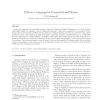150 search results - page 9 / 30 » What's next in high-performance computing |
DAC
1999
ACM
13 years 11 months ago
1999
ACM
ion model or flexible PCB solutions cannot offer a valid solution for the next millinium SoCs . James G. Dougherty, Integrated Systems Silicon LTD, Belfast, Northern Ireland ISS an...
IJCAI
1997
13 years 8 months ago
1997
Identifying user-dependent information that can be automatically collected helps build a user model by which 1) to predict what the user wants to do next and 2) to do relevant pre...
RC
2006
13 years 7 months ago
2006
If standard-precision computations do not lead to the desired accuracy, then it is reasonable to increase precision until we reach this accuracy. What is the optimal way of increa...
CPHYSICS
2007
13 years 7 months ago
2007
Python is a relatively new computing language, created by Guido van Rossum (Tanenbaum et al, 1990), which is particularly suitable for teaching a course in computational physics. ...
CCS
2011
ACM
12 years 7 months ago
2011
ACM
On the one hand, compilers for secure computation protocols, such as FairPlay or FairPlayMP, have significantly simplified the development of such protocols. On the other hand, ...

